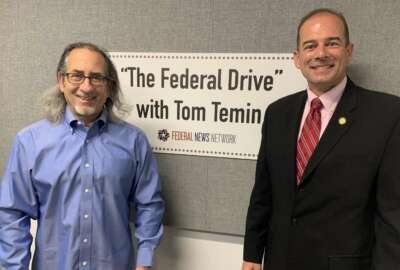
What it takes for a small agency to be a great place to work
The Selective Service System collects names on behalf of a place few Americans choose to work. Yet the Selective Service itself ranked in the top 10 of best places...
The Selective Service System collects names on behalf of a place few Americans choose to work. Yet the Selective Service itself ranked in the top 10 of best places to work among small agencies in the latest list. To find out the secret, Federal Drive with Tom Temin conducted an in-studio interview with Joel Spangenberg, the acting director of the agency.
Interview Transcript:
Tom Temin And you did choose that area as a retired naval officer. So you have been on the other end of the whole thing, too, which the Selective Service serves?
Joel Spangenberg That’s correct. I served in the Navy and, you know, it’s a part of the all-volunteer force, and it’s really an honor and a pleasure to continue serving the country.
Tom Temin Yeah, that’s kind of an irony because everyone has to register legally, all males in the United States when they reach the age of 18. And that is your job at the Selective Service for something that is unlikely to even happen. And so I would think that would mitigate against that being a good place to work. So tell us how you bridge that gap between seeming to do something that doesn’t matter, perhaps, yet it’s a compelling place to work.
Joel Spangenberg Right. Well, first off, maybe I could tell you a little bit about who we are and what we do as Selective Service. And I’ll give you a sense of, I think, the excitement we generate amongst the employees. First off, I’m very fortunate to have the opportunity to work with so many incredible people at the Selective Service System. I’m very proud of our workforce. Their dedication and commitment are on display every day and I’m happy to be part of such a great team.
Tom Temin How many are there, by the way?
Joel Spangenberg So right now we have 300 total compensated personnel. We have about 120 full-time employees, up to 57 part-time appointed state directors, over 100 reserve service members from the military services, so that’s part of the picture. But we also have the unique aspect of our agency, which allows us to have volunteers and we actually have over 9,000 volunteers, principally local board members and district appeal board members nationwide. So we have a pretty decent size for being a small agency.
Tom Temin And again, the irony, you know, of all the people that might have been militarily connected with the agency, now, none of them were ever drafted. I mean, it’s 50 years ago.
Joel Spangenberg That’s correct. I believe what makes it really interesting for us is that people see the enduring nature of what we do. And, you know, we had started as an independent agency with our roots over 100 years ago, and we’ve been a part of American history since then, during peacetime and during times of conflict. Ultimately, we support the national defense community and people are quite proud of that mission. So we do see ourselves as serving a critical role in ensuring that the nation’s military personnel needs are met in the times of national emergency and staying prepared to support that need.
Tom Temin All right. And operationally, what happens throughout the year?
Joel Spangenberg Throughout the year, I’d say one of the biggest things that people really do see, it’s registration. Like you mentioned before, young men are required to register for Selective Service System, and that’s the most visible aspect of what we do. But, you know, within the agency, we also have to make sure we stay ready. And that’s really a central tenet that runs through everything that’s required of us. So that means we have to be good on our planning, We have to do exercises and we have to work with our partners to make sure that we stay ready.
Tom Temin In other words, in a God forbid, situation for the nation, people might have to be called up. I mean, it’s a slim potential, at least for the last number of years, 50 years or so. But it’s not impossible.
Joel Spangenberg That’s correct. It’s not impossible. And going back many, many years, there’s been bipartisan consensus on keeping this agency as part of a national insurance capability, because we never know what tomorrow will bring. And, you know, we absolutely do not want to be caught flat-footed. So that is that drives a lot of the passion and the agency to make sure that we stay ready to protect the country if and when called.
Tom Temin And it comes up in Congress from time to time, but never seems to quite be enacted, is the idea of women being required to register, yet do you maintain the, I guess, unused apparatus should that happen?
Joel Spangenberg That actually is a very hot question. In fact, most recently there was interest in this during the FY 23 development of the Senate’s version of the National Defense Authorization Act. There was a provision that would include women. Ultimately, it was not included in the final legislation, but we monitor that very closely. So ultimately, it’s up to Congress to decide it’s a law. But if the law were to change, Selective Service System, as I said, we remain ready. We would work to implement whatever changes were needed. So I think we’re in a good position there, whatever direction we need to go.
Tom Temin We are speaking with Joel Spangenberg. He’s acting director of the Selective Service System and also a retired Navy officer. What is the mechanism? What’s the apparatus? You must have tentacles into all of the states and territories, databases of people. How does that work?
Joel Spangenberg Actually, I think you’re very correct in saying we do have a lot of great relationships with the states.
Tom Temin So that’s a better word than tentacles.
Joel Spangenberg We have, for instance, if we take a step back, we just can’t do it all alone from the federal government. We have to work with partners at the state level, especially. So inter-governmental partnerships are very important. So we work with governors’ offices, the National Guard across the country. We’ve even developed relationships working with the Department of the Interior to build relationships with tribal partners, even through our state directors in some states. So that builds into our readiness, that builds into registration. So like I said, it’s a team effort, but it’s also we work across the federal government. We work with partners, including the Department of Defense. That’s a big one for the Office of Personnel Management. Even with AmeriCorps, as we look at potential opportunities to build partnership around concepts of national service.
Tom Temin And are there any connections between the work that you’re doing and the recruitment efforts? I mean, the military services have had some challenges there for a variety of reasons of getting people just to volunteer. You know, everyone that could volunteer, some of them are not useful to the military given weight or whatever background conditions might have happened to them. But is there any relationship is there anything that you can offer that helps the armed services do the recruiting?
Joel Spangenberg Absolutely. And I think that’s a good opportunity to pause. I mean, this year is the 50th anniversary of the all-volunteer force. And having served in the all-volunteer force, I’m extremely proud of that. And I love what that force can do. And I love that Selective Service System has, since 2001, had an agreement in place with the Department of Defense to help support recruitment for the all-volunteer force. Principally, this is seen in us enclosing a brochure and registration acknowledgment letters that go to young men. So that’s an example of something that helps Department of Defense and they really appreciate it. And there are other organizations that are interested in working with us in that way, too, to help boost awareness about national service opportunities, because building that service ethos is really important for the federal government and for the nation.
Tom Temin Do you track the rates of registration because universal registration is required? Do some areas produce higher voluntary turnout, let’s say, than others?
Joel Spangenberg Yes. Right now for 18 to 25-year-olds nationally, based on the latest data, which is from calendar year 2022, we are at an 84% registration rate. That’s unfortunately a little bit down from calendar year 20 where we were at 89%. But the team has been working proactively to do things to try to work to get the rates up. But we also have to be responsive to things like, for instance, there was some federal legislation passed in 2020, the FAFSA Simplification Act, that delinked the registration requirement from federal student aid. So that actually passed in 2020 and the implementation went through 2022. So we saw the impact. We’re feeling it. We think we’re going to feel it more, but we are doing our best to counter that. So for instance, the team is working to work with influencers because we know people like coaches, high school counselors, they matter in helping to get the word out to young men about registration. And you know, this goes back to something you had mentioned earlier about working with partners nationally. One thing that we have in place is we have driver’s license legislation in 46 states and territories. That is extremely helpful for us. And what that means is when a young man gets a driver’s license or an identification card, for instance, they get registered or they have the opportunity to opt in to getting registered. So that’s really helpful. So we’re looking to build on that. So that builds on those partnerships as well. So we’re looking for ways to continue to do it. And even here in D.C., I can tell you quite proudly, the D.C. mayor last year signed into law legislation that would actually help boost awareness in D.C. of the registration requirement. And D.C. has had the worst registration requirement in the country among states and territories. So it’s great to see partners there trying to find ways to help ensure young men know about registration so they don’t miss out on very valuable federal benefits that can help them in life, both personally or professionally. And that that’s really, I think, a key message. We all want to see people have their futures protected and we also want to make sure people follow the law so this country –
Tom Temin Yeah. there’s that also, right?
Joel Spangenberg Yes, absolutely.
Tom Temin But on some level, you are also fighting demographics. You mentioned driver’s licenses in some of the coastal and urban areas, in affluent areas, maybe in some of the suburban areas, they don’t even feel like they want licenses compared to your generation or much older. My generation, where you were sitting behind the wheel at 15 and a half trying to not be noticed. But now, you know, fewer people are driving cars at that age.
Joel Spangenberg That’s actually a challenge. But I will say one thing that the agency has done well in recent years to do is to find ways to get more into social media, to meet young men where they really are, too. So not only are we trying to connect with influencers, but also we know young people like to be on their smartphones and they have their different apps, so we like to try to connect with them that way. So, you know, even though we might have a challenge with licenses, we’re still going to look for ways to help inform young men and their influencers the best we can.
Tom Temin All right. And you were, again, as we said at the top, among the top ten small agencies, best places to work. What do you do to ensure that happens?
Joel Spangenberg I think one of the key things I would just kind of take away from this is, you know, Selective Service does well because it really does care for its people. And we’ve created a respectful and inclusive culture in the agency. So I think that mission was something that’s really important. But I think the culture is also something that’s really set in and made a very positive difference. So some examples, our leaders at every level keep morale high by leading by example. Employees also feel very recognized for their talents, and these are results we saw in the Best Places to Work survey as areas that really stood out. The team has also done a great job of caring for the well-being of its employees, and this is something we talk about. We even have had an integrated project team that focused on quality of life, and I think that was very meaningful for people. So we’re bringing teammates together from across the agency to find ways to improve. And this continues. So we are actually continuing to focus on improving, looking at the FEVS and Best Places to Work results to help motivate us and drive us to be our best. So in recent months we had an employee team actually look at the FEVS results and help identify recommendations that went into an action plan that we are working to implement in the agency, so people know that we are committed to this. And I said that compelling mission makes a difference. And, you know, we’ve emphasized readiness, registration and management excellence very heavily in recent months. And as we modernize our capabilities, we also always work to make sure people know that everybody, no matter where they sit, what they do, they are connected to the mission. And we need everybody to make sure we’re successful. So obviously we have our eyes on continuing to move forward, but I’m very proud of the team and what they’ve done.
Tom Temin And just a quick question. Between your naval career and coming to the Selective Service, what did you do?
Joel Spangenberg Oh, I actually spent a large amount of my career in public service, so I worked as a professional staff member on the Senate Homeland Security and Governmental Affairs Committee staff. I worked in the Obama administration at the Department of Veterans Affairs and I’d been the chief of staff at Selective Service System as well for three years. And I spent a little time in the private sector as a management consultant. And I’m one of these people that’s had a career both on the political side and the career side. I’ve worked at Naval Reactors, National Nuclear Security Administration, and I was also the first ever executive director of operations at the Defense Nuclear Facilities Safety Board. So public service has meant so much to me. I’ve learned so many lessons about how important policy is, implementation is, but ultimately how important people are and how meaningful, very caring leadership is to the whole process.
Copyright © 2025 Federal News Network. All rights reserved. This website is not intended for users located within the European Economic Area.
Tom Temin is host of the Federal Drive and has been providing insight on federal technology and management issues for more than 30 years.
Follow @tteminWFED
Related Stories






